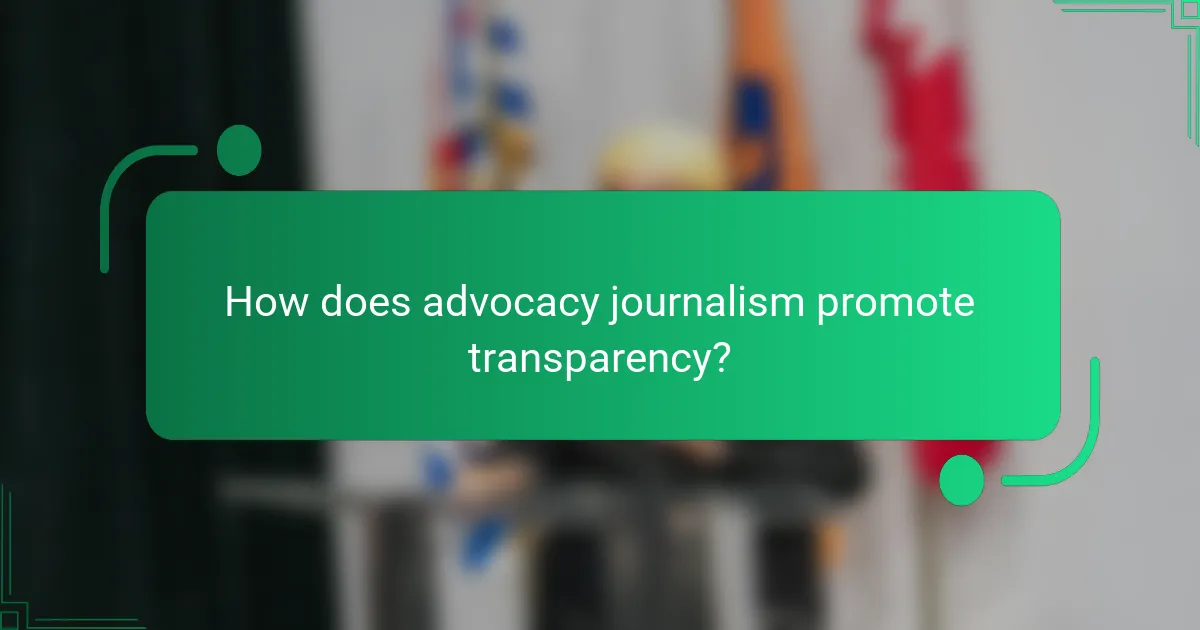Advocacy journalism plays a crucial role in promoting transparency by uncovering information that holds those in power accountable. By focusing on social issues and engaging with communities, this form of journalism fosters public discourse and reveals important truths. Adhering to ethical standards, such as truthfulness and transparency, ensures that advocacy journalism remains credible and impactful.

How does advocacy journalism promote transparency?
Advocacy journalism promotes transparency by actively seeking to uncover and disseminate information that holds power to account. This form of journalism often focuses on social issues, encouraging public discourse and revealing truths that may otherwise remain hidden.
Increased public awareness
Advocacy journalism raises public awareness by highlighting critical issues that affect communities and society at large. Through investigative reporting and storytelling, journalists can bring attention to topics like environmental justice, healthcare access, and human rights violations.
For instance, a report on pollution in a local river can mobilize community action and prompt governmental response. This increased awareness empowers citizens to engage with and influence policy decisions that impact their lives.
Accountability of institutions
This type of journalism plays a crucial role in holding institutions accountable by exposing corruption, malpractice, and systemic failures. By presenting evidence and compelling narratives, advocacy journalists can pressure organizations to change their practices and policies.
For example, a series of articles revealing unethical practices in a government agency can lead to investigations and reforms. This accountability fosters a culture of transparency where institutions are more likely to operate ethically and responsibly.
Empowerment of marginalized voices
Advocacy journalism amplifies the voices of marginalized communities, providing them with a platform to share their experiences and challenges. By focusing on underrepresented groups, journalists can highlight social injustices and advocate for change.
For example, stories featuring the struggles of low-income families in accessing healthcare can inform policymakers and the public about the need for systemic improvements. This empowerment not only raises awareness but also encourages active participation in the democratic process.

What are the key practices in advocacy journalism?
Key practices in advocacy journalism include rigorous fact-checking, active community engagement, and collaboration with non-governmental organizations (NGOs). These practices ensure that the journalism is not only credible but also resonates with the communities it aims to serve.
Fact-checking and verification
Fact-checking and verification are essential in advocacy journalism to maintain credibility and trust. Journalists must thoroughly investigate claims, using reliable sources and cross-referencing information to confirm accuracy.
Common methods include consulting primary sources, utilizing fact-checking websites, and engaging experts in relevant fields. Journalists should be aware of the potential for misinformation, especially in fast-paced news cycles, and prioritize accuracy over speed.
Engagement with communities
Engagement with communities is vital for advocacy journalism as it fosters trust and ensures that the issues reported reflect the community’s needs. Journalists should actively seek input from community members through interviews, surveys, and public forums.
Building relationships with local leaders and organizations can provide deeper insights into the community’s challenges and aspirations. This approach not only enhances the quality of reporting but also empowers communities by giving them a voice in the narrative.
Collaboration with NGOs
Collaboration with NGOs can enhance the impact of advocacy journalism by leveraging the expertise and resources of these organizations. NGOs often have access to valuable data, research, and grassroots networks that can enrich journalistic work.
Journalists should approach partnerships with NGOs carefully, ensuring that their independence is maintained. Clear agreements on roles, responsibilities, and ethical guidelines can help mitigate conflicts of interest while maximizing the benefits of collaboration.

What ethical standards govern advocacy journalism?
Advocacy journalism is guided by several ethical standards that ensure credibility and accountability. Key principles include a commitment to truthfulness, transparency regarding funding sources, and respect for privacy and consent.
Commitment to truthfulness
A commitment to truthfulness is fundamental in advocacy journalism, as it establishes trust with the audience. Journalists must verify facts, provide balanced perspectives, and avoid misleading statements, ensuring that their work reflects reality as accurately as possible.
Practitioners should implement fact-checking protocols and seek multiple sources to corroborate information. This diligence helps maintain integrity and supports the credibility of the advocacy message being conveyed.
Transparency in funding sources
Transparency in funding sources is crucial for maintaining the integrity of advocacy journalism. Journalists should disclose any financial backing that could influence their reporting, allowing audiences to assess potential biases.
For instance, if an organization receives funding from a corporation, this relationship should be clearly stated in the reporting. This practice not only builds trust but also helps readers critically evaluate the information presented.
Respect for privacy and consent
Respect for privacy and consent is essential in advocacy journalism, particularly when dealing with vulnerable populations. Journalists must obtain informed consent before using personal stories or sensitive information, ensuring that individuals are aware of how their data will be used.
Moreover, journalists should consider the potential impact of their reporting on the subjects involved. This includes weighing the benefits of public exposure against the risks to individuals’ privacy and safety, particularly in sensitive advocacy contexts.

How can advocacy journalism influence public policy?
Advocacy journalism can significantly shape public policy by raising awareness and pushing for change on critical issues. Through targeted reporting, it highlights injustices and mobilizes public opinion, which can lead to legislative action and reforms.
Shaping public opinion
Advocacy journalism plays a crucial role in shaping public opinion by presenting narratives that resonate with the audience’s values and beliefs. By focusing on specific issues, journalists can influence how the public perceives these matters, often swaying opinions toward a particular stance.
For example, coverage of climate change initiatives can lead to increased public support for environmental policies. This shift in perception can pressure policymakers to prioritize these issues in their agendas.
Highlighting social issues
By bringing attention to underreported social issues, advocacy journalism can illuminate problems that require immediate action. Investigative pieces often uncover systemic injustices, prompting discussions that may lead to policy changes.
For instance, reporting on homelessness can reveal the need for affordable housing solutions, encouraging local governments to allocate resources effectively. This type of journalism serves as a catalyst for addressing societal challenges.
Encouraging civic engagement
Advocacy journalism encourages civic engagement by informing citizens about their rights and responsibilities. It empowers individuals to take action, whether through voting, participating in protests, or engaging in community discussions.
For example, articles that explain the implications of new legislation can motivate readers to contact their representatives or participate in public forums. This engagement is essential for a healthy democracy, as it fosters accountability among elected officials.

What challenges do advocacy journalists face?
Advocacy journalists encounter several significant challenges that can impact their work and effectiveness. These include maintaining credibility while addressing bias, navigating funding pressures, and facing potential legal threats or censorship.
Risk of bias and credibility issues
Advocacy journalism often involves promoting specific causes, which can lead to perceptions of bias. Journalists must strive to present balanced viewpoints while advocating for their causes, as failure to do so can undermine their credibility. Maintaining transparency about their motivations and sources is essential for building trust with audiences.
To mitigate bias, advocacy journalists can employ fact-checking practices and cite diverse sources. Engaging with critics and presenting counterarguments can also enhance the credibility of their reporting.
Pressure from funding sources
Funding sources can exert significant pressure on advocacy journalists, potentially influencing the content and direction of their work. Journalists may feel compelled to align their reporting with the interests of donors or sponsors, which can compromise journalistic integrity. Understanding the motivations behind funding is crucial for maintaining independence.
To navigate funding pressures, journalists should seek diverse funding streams and be transparent about their financial backers. Establishing clear editorial guidelines can help safeguard against conflicts of interest.
Legal threats and censorship
Advocacy journalists often face legal threats and censorship, particularly when reporting on sensitive issues. Governments or organizations may attempt to silence dissenting voices through lawsuits or intimidation tactics. Awareness of legal rights and protections is vital for journalists operating in restrictive environments.
To protect themselves, advocacy journalists should familiarize themselves with media laws and regulations relevant to their region. Building networks with legal experts and organizations can provide support and resources in the event of legal challenges.

How is advocacy journalism evolving in the digital age?
Advocacy journalism is rapidly evolving in the digital age, driven by technological advancements and changing audience expectations. Journalists now leverage online platforms to amplify their voices, engage with communities, and promote social change more effectively than ever before.
Use of social media platforms
Social media platforms have become essential tools for advocacy journalists, enabling them to reach wider audiences instantly. Platforms like Twitter, Facebook, and Instagram allow journalists to share stories, engage with followers, and mobilize support for causes in real-time.
However, the fast-paced nature of social media can lead to the spread of misinformation. Advocacy journalists must verify facts before sharing to maintain credibility and trust with their audience.
Emergence of citizen journalism
The rise of citizen journalism has transformed the landscape of advocacy journalism, allowing everyday individuals to report on issues that matter to them. This grassroots approach often brings attention to underreported stories and provides diverse perspectives that traditional media may overlook.
While citizen journalism enhances the richness of the media landscape, it also raises questions about accuracy and ethical standards. Advocacy journalists should collaborate with citizen journalists to ensure that stories are well-researched and credible.
Integration of multimedia storytelling
Multimedia storytelling is increasingly important in advocacy journalism, as it combines text, images, audio, and video to create compelling narratives. This approach helps to engage audiences more deeply and convey complex issues in an accessible manner.
Advocacy journalists should consider using infographics, podcasts, and video reports to enhance their storytelling. By diversifying content formats, they can cater to different audience preferences and improve the overall impact of their advocacy efforts.
